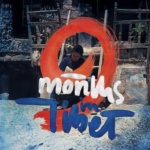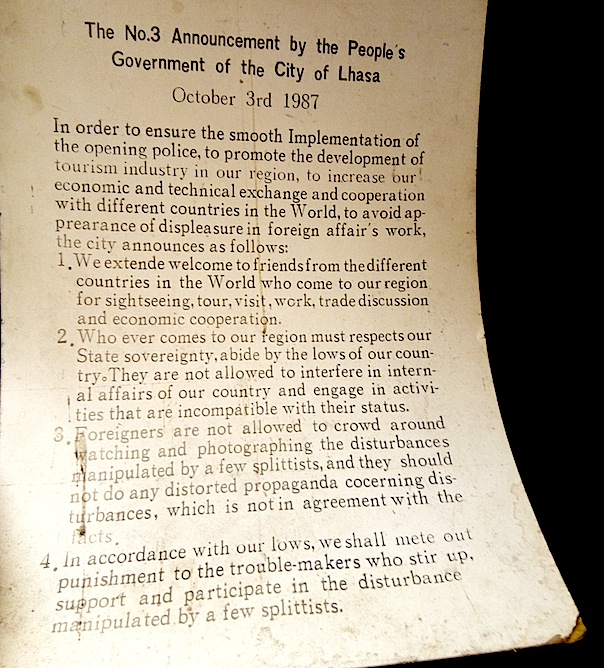by Rupert Wolfe Murray
Before I write about my observations of Nepal, I want to describe my last visit to this fascinating little Himalayan country.
Thirty years have passed since I was last in Kathmandu. My presence there was both dramatic — I had been kicked out of Tibet — but also depressing: I was broke, my dream of living in Tibet had been shattered and I couldn’t afford to fly home to Scotland.
I didn’t want to be in Nepal and I didn’t really notice it (yesterday I told a Nepalese man that I was here 30 years ago and he said “that was the golden time” before uncontrolled building development and pollution). Back then I didn’t take in the ancient buildings and culture and spent my time writing an article for the Daily Telegraph — an article that got me £500, a ticket home and a foothold in journalism.

The last chapter of my memoir, 9 Months in Tibet, describes the political situation in Tibet that led to my expulsion. But there are some things which I never wrote about, one of them being the government poster that appeared all over Lhasa on the 3rd of October 1987 — offering a sort of amnesty to the rioters.
The poster, which is the subject of this article, hasn’t been reproduced anywhere as far as I’m aware and so, in a small way, maybe this article is a historical document about the Chinese occupation of Tibet (for those of you who don’t know what happened, the Tweetable version is this: China invaded Tibet in 1949. They promised autonomy, killed millions and destroyed the culture. The Dalai Lama fled in 1959 and set up a Government in exile in India.)
3rd October 1987: the Government Poster in Tibet
It was badly written, typeset in the old fashioned way and printed on thin white paper. I ripped a copy off the wall and smuggled it out of the country — oblivious to the risk of getting caught.
The poster was just text and its title was simple:
No. 3 Announcement by the People’s Government of the City of Lhasa
October 3rd 1987
The first part of the poster sounded diplomatic in tone, but if it had been drafted by diplomats they weren’t very good at English. My rendering of the poster is verbatim, in other words I didn’t correct their spelling.
By the end of the text the anger the Chinese felt towards the Tibetan protesters, and us foreigners, became clear.
Here is the full text:
In order to ensure the smooth Implementation of the opening police, to promote the development of tourism industry in our region, to increase our economic and technical exchange and cooperation with different countries in the World, to avoid appearance of displeasure in foreign affair’s work, the city announces as follows:
- We extende welcome to friends from the different countries in the World who come to our region for sightseeing, tour, visit, work, trade discussion and economic cooperation.
- Who ever comes to our region must respects our State sovereignty, abide by the lows of our country. They are not allowed to interfere in internal affairs of our country and engage in activities that are incompatible with their status.
- Foreigners are not allowed to crowd around watching and photographing the disturbances manipulated by a few splittists,and they should not do any distorted propaganda concerning disturbances, which is not in agreement with the facts.
- In accordance with our lows, we shall mete out punishment to the trouble-makers who stir up, support and participate in the disturbance manipulated by a few splittists.
Points three and four remind me of the story of the riot and the Chinese reaction to it.

This is what happened: some monks protested against Chinese rule, the police opened fire, killed several protesters and arrested others. A Tibetan mob stormed the police station where the prisoners were being held and burned the place down. I turned up towards the end of the riot, saw a boy shot dead in front of me and spent the next few days working out what had happened.
A lot of foreign travellers were in Lhasa that day (1st of October 1987) as well as some journalists. Not only were photos and testimonials taken but they were smuggled out (the Chinese police were naive in the ways of the wily foreign journalists back then and they didn’t search those leaving). The international media told the story in gory detail and it was headline news for a few days. I remember thinking that the Chinese government would have felt humiliated by this outbreak of bad news and their revenge on the Lhasa population would be terrible.
The Chinese police were outraged that the Tibetans had protested against what they consider to be an enlightened regime. They assumed the rioters had been organised by the “Dalai Lama clique” and foreign spies like me (I was an English teacher in Lhasa but I always fancied myself as the next James Bond). They also invented a new word; “splittist”, meaning someone who wants to split Tibet away from the Chinese motherland.
The Chinese police gave the Tibetans a few days to confess all, hand themselves in and benefit from an amnesty. None of the Tibetans I spoke to trusted this amnesty and I don’t think anyone handed themselves in.
Soon enough the police cracked down, abducted people at night and tortured them in Lhasa’s notorious prison. They fulfilled point 4 of their foreign language poster: In accordance with our lows, we shall mete out punishment to the trouble-makers who stir up, support and participate in the disturbance manipulated by a few splittists.
A few days later I was arrested, told to write a self-criticism, which I refused to do, and ordered to leave China within 4 days. I organised a bus to the Nepalese border, a journey that took 4 days over unpaved roads, and ended up feeling glum in Kathmandu.
I wrote about my experiences in Tibet and this helped me to move on. I didn’t want to carry the terrible burden of Tibet’s tragedy for the rest of my life and so I didn’t get involved in the Free Tibet movement. I got into journalism instead, covered the Romanian revolution and spent the next 20 years in Eastern Europe.
Now that I am back in Nepal I can lay the ghost of the past (I don’t want to go back to Tibet in this lifetime), and I can look at this little Himalayan country with fresh eyes: in 1987 I saw Nepal as a transit point and safe haven; now I see it as a fascinating country in its own right and a place I intend to explore.
You can join me by reading these articles and adding a comment.
- 1917 (2019) - 11th January 2020
- The Shakespeare Soap Opera - 10th June 2016
- On the Road with Madame Bovary - 4th April 2016










